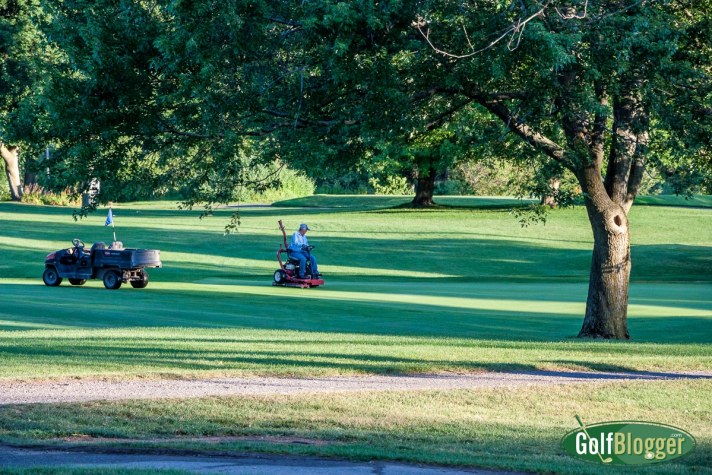
Two of Washtenaw Golf Club’s greenskeepers mowing the fairways.
In Praise of Greenskeepers
Not nearly enough praise is heaped on greenskeepers.
Up before dawn, they are hard at work on with their mowers, tractors, blowers and rakes to get our golf courses in shape for the day’s play. Most golfers don’t give them much thought because the maintenance is usually done before the vast majority show up at the course.
There is a sense in which the best measure of how well greenskeepers do their jobs is whether or not you think about the greenskeeping. I suspect most only think about the groundskeepers if the conditions are subpar.
As a dedicated dewsweeper, however, I get to see the tail end of their morning labors, whether at Washtenaw Golf Club or on one of my many early morning road trips to play other Michigan courses. For the most part, I’m impressed with the work I see done around the state. Where conditions suffer, I suspect that the fault lies with underinvestment by management, rather than with some long-suffering grounds superintendent.
And even with underinvestment, I get the sense that greenskeepers have figured out ways to get the most out of every penny. They’re probably like teachers, getting more done every year with less.

Greenskeeping is not just riding around on machines. There’s a skill to it. I had a chat with one of Washtenaw’s longtime greenskeepers, Tom, about how he was training another guy on how to properly cut the course’s square greens. He also talked about how the color of a green can tell you whether it’s good to go, or if you are about to lose it. I was surprised to learn that purple is a color to look out for.
I really hadn’t thought about it until then, but like every other job worth doing, there is a specific and valuable skill set.
Consider some of the things greenskeepers must do on a daily basis to make our courses playable:
- Mowing fairways, secondary cuts, and rough to the proper heights, making sure that while doing so, they retain the fairway widths and shapes.
- Properly repairing fairway divots.
- Mowing teeing areas to their nice sharp corners and repairing divots.
- Properly fixing ball marks, then mowing and rolling greens to a consistent speed, all the while ensuring that the greens neither shrink nor expand in area.
- Aerating and sanding
- Moving the holes around the greens to balance wear and playability.
- Moving tees to even wear.
- Seeding
- Precisely watering the course so that it is neither too wet, nor too dry.
- Guarding the course against excess heat, and in the winter, excess cold.
- Properly fertilizing (anyone who has a lawn at home knows how easy it is to over- or under-fertilize.
- Applying potentially toxic pesticides (everyone has seen those signs near the first tee or in the clubhouse notifying about applications).
- Blowing cuttings away from the fairways
- Trimming trees and other growth to ensure that lines of play are maintained.
- Clearing debris and leaves.
- Raking bunkers and cutting their edges
- Maintaining the machinery and tools
I am positive that there are hundreds more things I have not yet observed. As early as I get out, so much work is already done by the time I get there; much more is done after I am gone.

Overseeing the whole groundskeeping operation at Washtenaw is its Superintendent, Mark Pappas. The beauty and pristine conditions of the course are a testament to his skills and dedication. I’ve played twenty different courses this summer in Michigan and the best I’ve seen are at Washtenaw and Boyne in Northern Michigan.
Also a testament: this week, Mark will be one of the volunteer greenskeepers keeping Detroit Golf Club pristine for the Rocket Mortgage Classic. Those will be sixteen-hour days for him. When you watch the tournament, know that the fairway cuts are his domain.


Discover more from GolfBlogger Golf Blog
Subscribe to get the latest posts sent to your email.

